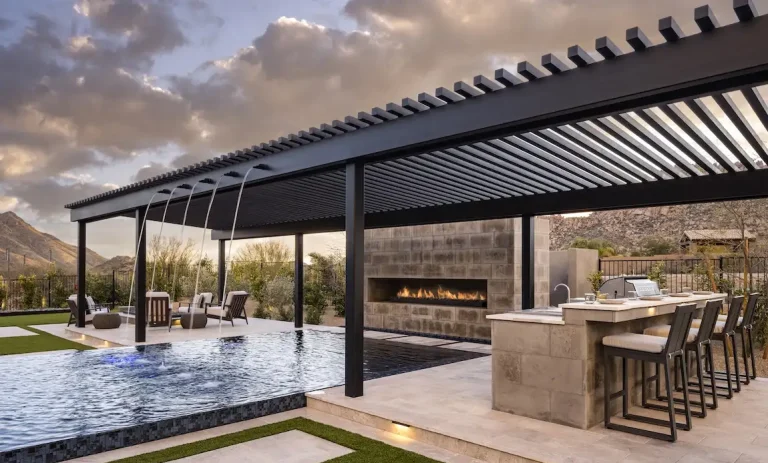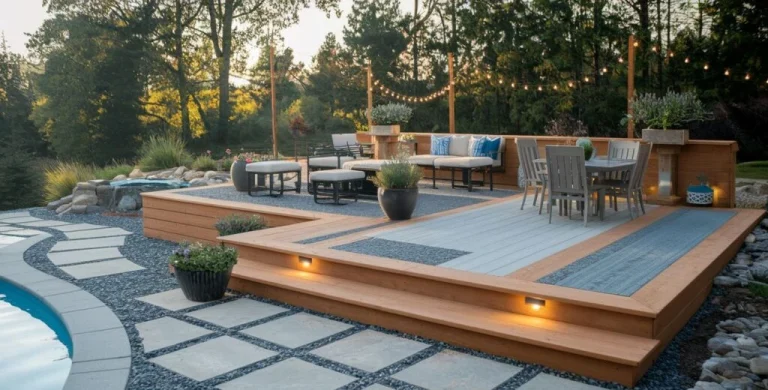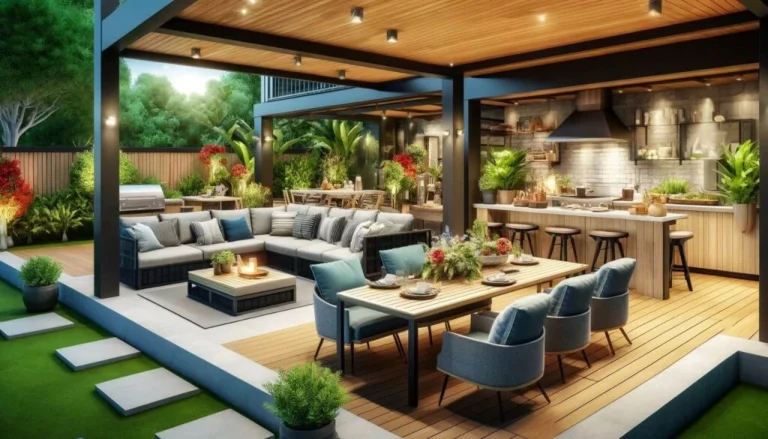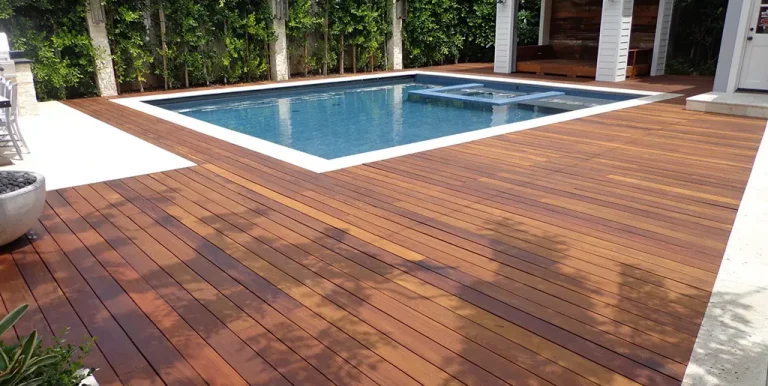Built-in Deck Lighting: Enhance Your Deck with Integrated Illumination
Types of Built-in Deck Lighting
Recessed / Flush Deck Lights
Recessed (or flush-mounted) lights are installed directly into the deck boards or stair risers so that their lens sits nearly flush with the surface. These “deck dots” or disc-style lamps provide subtle, downward lighting to illuminate walking surfaces and edges without glare.
These lights are especially useful along perimeters, stairs, pathways, and transition places where you want visibility but not visually obtrusive fixtures. Many are designed for composite, wood, or PVC decking and are waterproof and durable for outdoor use.
When properly installed, recessed deck lights integrate seamlessly into the deck surface, rendering them nearly invisible during the day but effective at night.
Post-Cap / Rail / Riser Integrated Lighting
In addition to deck-board lighting, many systems integrate lights into posts (post caps), railings, or risers. For example:
-
Post-cap lights: LED modules installed into the top or side of deck posts, offering an ambient glow that outlines the deck boundary.
-
Riser lights: Mounted into stair risers to softly illuminate steps, improving safety on stairs and changes in elevation.
-
Rail/under-rail lighting: LED strips or puck lights hidden under railing profiles, casting light downward across decking surfaces or adjacent landscape.
These types allow ambient, indirect lighting that accentuates architectural features while providing functional illumination.
Integrated LED Strip / Linear Modules
Some modern deck lighting systems use narrow LED strips or linear modules built into grooves or channels alongside decking boards or underneath overhangs. These can be hidden in grooves or profiles so the light is subtle but continuous along edges, steps, or corners.
Such modules often allow dimming, color temperature control, or RGB effects, making them ideal for creating ambient mood lighting in entertainment settings.
Benefits of Built-in Deck Lighting
Enhanced Safety and Navigation
One of the strongest reasons to adopt built-in deck lighting is safety. Well-placed illumination reduces the risk of trips, falls, or missteps, especially on stairways, edges, or deck transitions. Recessed lights along walkways or risers make each step visible, even in low-light conditions.
By eliminating harsh glare and using low-level lighting, built-in systems provide just enough light to see clearly without overwhelming brightness. This makes nighttime use comfortable and secure.
Aesthetic and Architectural Integration
Built-in lighting enables a refined, cohesive design. Since fixtures are embedded or integrated, they don’t interrupt the visual lines of the deck. During the daytime, they are largely unobtrusive and may blend or disappear. At night, they highlight textures, materials, and structure in a sophisticated way.
This seamless integration is a key advantage over surface-mounted lights, which can appear bulky, inconsistent, or disruptive. A well-lit deck elevates the overall architectural appeal of the home and outdoor space.
Energy Efficiency and Longevity
Most built-in deck lighting systems use LEDs, which draw significantly less power than traditional incandescent or halogen bulbs. Many systems operate on low-voltage DC, making them safer and more efficient.
LEDs also offer long life, often tens of thousands of hours, and require minimal maintenance. With sealed waterproof housings, they resist outdoor elements, minimizing failure or corrosion over time.
Improved Usability & Lighting Flexibility
By integrating lighting into the deck, you extend the usability of your outdoor space into evening hours. Rather than relying on external floodlights, the lighting becomes ambient, flexible, and more controllable.
Many modern systems support dimming, RGB color control, or smart home integration, allowing you to tailor the lighting for social gatherings, quiet evenings, or accent illumination. This flexibility enhances how the deck is used and experienced.
Added Property Value & Premium Appeal
Homes with well-designed outdoor lighting often command greater appeal and value. Built-in deck lighting suggests a more finished, premium outdoor living space. For potential buyers or renters, a beautifully lit deck is a strong selling point.
From a builder or contractor’s perspective, offering integrated lighting packages can justify higher pricing and increase client satisfaction.
Real-World Product Examples
Below are five real product examples of deck lighting or lighting systems that integrate well with built-in decking designs. Each includes details, features, use cases, and purchasing info.
1. Hinkley Taper LED Step Light

The Hinkley Taper LED Step Light is designed to be mounted within steps or risers, producing a soft downward glow. It’s compact, durable, and engineered for outdoor use.
This fixture is especially suited to lighting stair risers and transitions. When installed flush into riser surfaces, it delivers subtle, directed light that improves safety without glare. Because it’s built into the structure, it aligns with the idea of built-in deck lighting.
It is engineered with weather-resistant housing and LED modules that ensure consistent performance even in damp conditions.
2. Solar Deck Lights – 4-Sided Glow

The Solar Deck Lights 4-Sided Glow unit is a solar-powered, freestanding fixture designed to be embedded or mounted into decking surfaces or posts. With 360° illumination, it creates a continuous ring of light around its housing.
Because it’s solar-powered, it doesn’t require wiring through the deck, making it more flexible and DIY-friendly for retrofit installations. It works well in garden decks, perimeter layouts, or in locations where running wiring is challenging.
Its 4-sided glow distributes light evenly and emphasizes boundaries without harsh spotlighting.
3. Osculati Underwater / Deck Light

The Osculati Underwater Light can also serve dual functions for deck edge lighting near water or low spots. Its marine-grade construction and waterproof design make it durable for exterior deck exposure.
When installed near deck edges or in trim channels, it casts illumination outwards, highlighting deck boundaries or adjacent water features. While it’s built for tougher marine conditions, its integration into decking edges or trim is a strong feature for decks near pools, ponds, or docks.
4. Trex Recessed Deck Lights (Trex Outdoor Deck Lighting)

Trex offers recessed deck lights designed to be installed flush in deck boards or steps. These are part of the Trex Outdoor Deck Lighting brand. They use low-voltage LEDs (often Cree) and are sold as complete kits, including plug-and-play connectors and a LightHub system, making installation easier.
These recessed lights can be used in composite or wood decks to highlight perimeters, stairs, transitions, or architectural features. By embedding them into boards, they fulfill true built-in lighting functionality with minimal disruption to deck design.
5. DEKOR Recessed Deck “DekDot” Lights

DEKOR’s DekDot recessed lighting modules are extremely low-profile LED dots designed specifically for decks, stairs, docks, and hardscape surfaces. Their waterproof design and modular connectivity allow for flexible layouts.
These lights are suitable for embedding flush in composite boards or wood, offering ambient point lighting that blends into the deck. They are versatile and often used for pathway, perimeter, and accent lighting.
Detailed Product Insights & Comparisons
When choosing among these lighting options and integrating them into a deck, consider the following detailed attributes:
-
Power & wiring: Solar units (like the Solar Deck Lights) need no wiring but depend on sunlight, while LED modules and recessed lights (such as Trex or DEKOR) use low-voltage DC and require wiring, transformers, and splice connectors.
-
Mounting depth: Recessed lights require a cut-out or routing of the deck board or riser. Ensure board thickness allows the fixture to sit flush without compromising the structure.
-
Waterproofing & IP rating: Outdoor lighting must manage moisture. Most good deck lighting modules are sealed to at least IP65 or higher.
-
Color temperature & beam angle: Warm white (2700–3000K) is often preferred for decks for a cozy feel. Narrow beam lights are for spot accents; wide beam lights are for walkway illumination.
-
Smart controls and dimming: Some systems integrate with smart home platforms, allowing scheduling, dimming, or RGB control.
-
Lifetime & maintenance: LED modules often last 50,000+ hours. Solar units may degrade over the years; wiring systems allow modular replacement.
Putting this all together, recessed or embedded LED systems (Trex, DEKOR) best satisfy built-in lighting premium expectations; solar or external modules supplement in spots.
Use Cases & Problems Solved
Use Case: Stair Safety in Landscape & Deck Transitions
On multi-level decks or where steps lead up/down, poor visibility in low light is a hazard. Built-in riser or recessed lights illuminate steps subtly, helping users see edges, preventing trips, and guiding movement.
For example, embedding Hinkley Taper or Trex recessed lights into stair risers ensures each step is lit without bulky fixtures or obstruction.
Use Case: Ambient Boundary Lighting Without Harsh Glare
Perimeter or boundary lighting is essential to define deck edges. Rather than using bulky post-mounted lights, recessed or post-cap integrated lights (e.g., DEKOR DekDot or Trex post-cap) softly outline the deck, enhancing ambiance and usability without glaring brightness.
Use Case: Poolside or Waterfront Decks
Decks near water need careful lighting, glare, reflections, and safety near edges; all matter. Systems like Osculati Underwater Lights or recessed LEDs in trim zones help accent boundaries while handling moisture and splash zones.
Use Case: Architectural & Modern Deck Designs
Contemporary decks often favor minimalism and hidden features. Built-in lighting aligns with that aesthetic. For designers, embedding linear LED modules or flush deck dots keeps surfaces clean and architectural integrity intact.
Use Case: Retrofitting an Existing Deck
Even for existing decks, built-in lighting can be retrofitted by routing channels in deck boards or adding riser inserts. Solar-embedded units provide flexibility where wiring is difficult. Thus, built-in lighting is not limited to new construction.
These use cases show how built-in lighting addresses both functional (safety, navigation) and design (aesthetics, ambiance) needs.
How to Choose, Buy & Install Built-in Deck Lighting
Planning & Design Considerations
-
Begin lighting design early. Plan for wiring, power sources, and placement before final decking installation.
-
Map out the deck in zones: stairs, edges, walking paths, accent areas, a nd assign appropriate light types (recessed, post, strip).
-
Calculate power load: sum LED wattages, include transformer headroom, and space transformers centrally if possible.
-
Choose cables rated for outdoor, low-voltage use; protect connections with waterproof enclosures.
Installation Best Practices
-
Cutouts and Routing
Use router bits sized to the lighting fixture depth. Make sure the back of the fixture doesn’t protrude into structural voids or conflict with joists or wiring. -
Secure Mounting & Sealing
Seal edges around embedded fixtures with silicone or a gasket for waterproofing. Use screws or clips as specified by the manufacturer. -
Wiring & Electrical Safety
Run low-voltage cable through conduit or protective sheath. Avoid stress on connectors. Use junction boxes or splice kits rated for outdoors.
Use transformers with adequate wattage and voltage drop compensation. Many kits combine timers or photocells. -
Dimming & Control Integration
If dimming or color control is desired, include a dimmable driver or controller. Choose systems compatible with smart home hubs or wall dimmers.
Always follow the manufacturer’s wiring diagrams to avoid damaging LED modules. -
Testing & Commissioning
Before final closure, power up and test all lights. Verify that brightness, color, and uniformity meet expectations. Fix issues early before final finishing. -
Future Maintenance Access
Document wiring paths and maintain a map of fixtures. Use modular connectors so individual lights can be replaced. Avoid burying junctions out of reach.
Where to Buy & Sample Affiliate Links
You can purchase integrated deck lighting from specialty lighting and deck accessory retailers.
-
Trex Recessed Deck Lights – part of Trex Outdoor Deck Lighting kits.
-
DEKOR DekDot Recessed LED Modules – via DEKOR Lighting.
-
Hinkley Taper LED Step Light – outdoor fixture suppliers.
-
Solar Deck Lights 4-Sided Glow – solar outdoor lighting sellers.
-
Osculati Underwater / Deck Light – marine and outdoor lighting shops.
You may also consult local outdoor lighting and deck accessory vendors—especially in your country or region to avoid high shipping costs or import delays.
Installation Challenges & Solutions
-
Limited Deck Board Thickness: Some decking boards may be too thin to recess a fixture flush without weakening. Choose ultra-low-profile lights or use riser-mounted solutions.
-
Power Drop & Wire Runs: Long cable runs lead to voltage drop and dimming problems. Counter this by using heavier gauge wire, distributing transformer locations, or clustering zones.
-
Moisture and Water Ingress: Outdoor lighting must resist moisture. Use sealed housings, silicone gaskets, and elevated junction boxes.
-
Heat Management: Although LEDs produce limited heat, ensure they are not installed in fully sealed cavities without ventilation.
-
Retrofitting Older Decks: Existing decks may lack wiring conduits. Use surface-mounted channels or solar-embedded units where routing is infeasible.
-
Matching Look & Finish: Ensure fixture color, lens style, and brightness align with deck materials to avoid visual disruption.
By anticipating these challenges and selecting modular, well-documented systems, most installations can succeed with minimal surprises.
Long-Term Benefits & ROI
Built-in lighting is not just decorative; it offers long-term functional value. Over time, the benefits accumulate:
-
Lower maintenance and replacement costs compared to bulky external fixtures.
-
Higher usability of outdoor spaces after dark, extending the functional hours of your deck.
-
Increased aesthetic appeal can enhance property value and marketability.
-
Energy efficiency savings thanks to LED technology and smart controls.
-
Reduced risk of accidents from better illumination.
Even though the upfront cost is higher than basic surface lighting, many homeowners find that the return both in enjoyment and resale value makes the investment worthwhile.
Frequently Asked Questions
Q1: Can built-in deck lighting be installed on any deck material (wood, composite, PVC)?
Yes, in many cases. The main constraint is board thickness and structural depth. Composite and wood boards often allow recesses or routed channels, while PVC decking may require specific compatible fixtures. Always confirm that your lighting modules are compatible with the decking material and that you have sufficient thickness for flush installation.
Q2: What is the typical power source or wiring method for built-in deck lights?
Most built-in lighting systems use low-voltage DC (12V or 24V) supplied via a transformer/driver. Wiring should use outdoor-rated cable, junction boxes rated for moisture, and proper connectors. Dimming or control modules may be integrated. Solar-powered embedded lights exist, too, eliminating the need for wired power.
Q3: How far apart should built-in deck lights be spaced?
Spacing depends on the light’s beam angle, brightness, and purpose (walkway, accent, perimeter). A common guideline is every 18–24 inches along stair nosing or every 3–4 feet along deck perimeters. For deck dots or pathway lighting, test uniformity before committing to spacing. Always follow manufacturer recommendations for spacing to prevent oversaturation or dark gaps.





